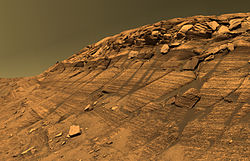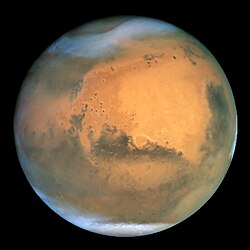Lista över kratrar på Mars

Det finns hundratusentals nedslagskratrar på planeten Mars större än 1 km, men endast ett tusental av dem har namn. Namnen ges av den Internationella astronomiska unionen efter förslag av relevanta forskare, och kratrarna kan endast namnges efter avlidna personer. Kratrar med en diameter på under 60 km ges namn efter kända forskare och science fictionförfattare, medan de med en diameter över 60 km ges namn efter städer på jorden.
Detta är en lista över alla namngivna martianska kratrar. Langitud och longitud som ges är planetografiska koordinater med västlongitud.
Per bokstav
Se även
 Wikimedia Commons har media som rör Lista över kratrar på Mars.
Wikimedia Commons har media som rör Lista över kratrar på Mars.- Lista över berg och bergskedjor på Mars
Externa länkar
| ||||||||||||||||||||||||||||||||||||||||||||||||||||||||
Media som används på denna webbplats
NASA's Hubble Space Telescope took the picture of Mars on June 26, 2001, when Mars was approximately 68 million kilometers (43 million miles) from Earth — the closest Mars has ever been to Earth since 1988. Hubble can see details as small as 16 kilometers (10 miles) across. The colors have been carefully balanced to give a realistic view of Mars' hues as they might appear through a telescope. Especially striking is the large amount of seasonal dust storm activity seen in this image. One large storm system is churning high above the northern polar cap (top of image), and a smaller dust storm cloud can be seen nearby. Another large dust storm is spilling out of the giant Hellas impact basin in the Southern Hemisphere (lower right).
Burns Cliff inside of Endurance Crater
This image was downloaded off of NASA's website and has the same permissions as other images on this wiki topic (en:Opportunity rover). This image has been cropped and has had missing sky pixels filled in.
The image is based on an approximate true-color mosaic based on multiple frames taken through color filters. The color is approximate because the red filter is actually an infrared filter, which is used more often than a true red filter by the rovers for its scientific value. The rovers do have a red filter, but due to the limits of data transmission from Mars, it is often not used. Some suggest that the actual sky color would have a bit more orange in it if a true red filter was used.
Opportunity had a bit of difficulty reaching this spot due to the slope. Its recorded wheel movement indicated a high degree of slippage.

